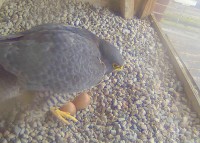Lawrence Peregrines: last days of incubation
May 7, 2018 in In the Nest Box, lawrence peregrines, Peregrine Falcons Eastern Massachusetts, Peregrine Falcons Massachusetts
Just before 6AM, the peregrines had overcast skies with fog/mist, winds from W at 3MPH, and temp at 54F. The day ahead calls for patchy fog before 8am. Otherwise, partly sunny, with a high near 63. Calm wind becoming northeast 5 to 8 mph in the morning. The good news: last week when it seemed as though we went straight from winter weather into summer heat and humidity…..well, spring is very much back in the forecast this week!
 At 6:08 AM, the female, who had been incubating, rose up slowly. She had spent a few minutes before preening. She was very careful with the eggs, and seemed to make a few gentle adjustments to their position with her right talon. Then she slowly moved to the right edge of the nest box, and paused for a long moment prior to departure on the wing. She returned two minutes later, and settled quickly on the eggs.
At 6:08 AM, the female, who had been incubating, rose up slowly. She had spent a few minutes before preening. She was very careful with the eggs, and seemed to make a few gentle adjustments to their position with her right talon. Then she slowly moved to the right edge of the nest box, and paused for a long moment prior to departure on the wing. She returned two minutes later, and settled quickly on the eggs.
The last days of incubation! Incubation is almost finished. Only a few days more. Full incubation typically starts when the penultimate, or second to last egg is laid. That puts us around day 27. Hatching can start as soon as on day 29 to 31. So things are getting very exciting!
 * The scales, claws, and beak are becoming firm
* The scales, claws, and beak are becoming firm
* The embryo turns its beak toward the air cell.
* The chorioallantoic cavity lines most of the inside surface of the egg shell.
Growth is happening fast now as well as the ossification process. The embryo is using the left over food in the egg and this creates more space. The almost ready eyas is beginning to prepare for the hatching process. It is essential the little one takes in the right position for hatching. About three days before hatching, the embryo’s head burrows beneath the right shoulder so the beak is positioned under the wing & against the two membranes separating the embryo from the air space at the large end of the shell. The air cell is getting larger due to evaporation inside the egg.
During the last days before hatching the first down is growing, so the eyas will have some protection after it has hatched. But it will still need all the protection it can get from it’s parents. The lungs have started to develop as well. As soon as the eyas will pip the air cell the lungs will fill itself with oxygen for the very first time. The hatching process starts 48 hours before the eyas has freed itself from the eggshell. As soon as it pips the membrane to the air cell it will start “singing”. The reaction of the parents on that will be very visible on the refresh! So keep an eye on the New Balance Falcon Cam!
Literature cited: Veldhuis, Froona, Last Days of Incubation, Sept 27, 2008 http://falcoperegrinus-froona.blogspot.com/search/label/embryonic%20development
